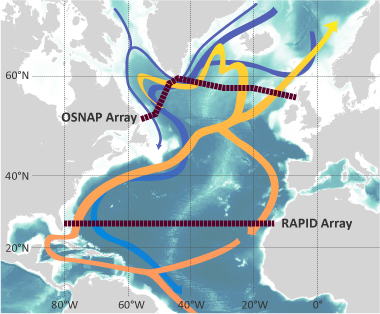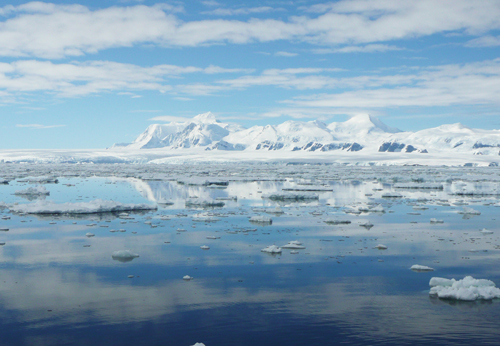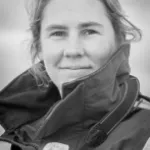UK OSNAP aims to relate the variability of the overturning circulation of the North Atlantic with formation of deep water and basin-scale wind forcing.
What are we doing?
The UK-OSNAP team is developing a new observing system and innovative modelling techniques to characterise the circulation and fluxes of the North Atlantic Subpolar Gyre. We will provide a continuous record for four years (2014–18) of full-depth, trans-basin mass, heat, and freshwater fluxes in the Subpolar Gyre. UK-OSNAP will be part of an international collaboration to establish a transoceanic observing system in the subpolar North Atlantic (the OSNAP array). Our second aim is to quantify and understand the Subpolar Gyre’s response to local and remote forcing of mass, heat and freshwater fluxes, within the conceptual framework of the AMOC.
To achieve the aims, we have a suite of specific project objectives:
- to contribute to the OSNAP array with measurements in the Deep Western Boundary Current in the Irminger Basin, and the Eastern Boundary,
- to generate a seasonally-resolved time series of Subpolar Gyre circulation and isopycnal and diapyncal mixing rates and their contribution to net fluxes of heat and freshwater, from 2001, and for each of the Subpolar Gyre sub-basins. We will use a new inverse method applied to Argo data and supplemented by ECCO ocean state estimates,
- to identify the link between Subpolar Gyre heat storage and convergence in ocean heat transport. We will use dynamical assimilation and forward model experiments to develop diagnostics of ocean heat content change and heat transport convergence, and to explore the link to atmospheric forcing regimes,
- to quantify and understand the local and remote causes of the observed Subpolar Gyre variability using a combination of adjoint modelling at non-eddying resolution to determine sensitivities, and high resolution eddy-permitting forward modelling to test sensitivity robustness,
- to develop metrics appropriate to the Subpolar Gyre mass, heat and freshwater fluxes, by exploring improvements to the ‘flat’ and ‘tilted’ metrics via inclusion of horizontal circulation and Ekman fluxes, and testing in models, inverse solutions and the OSNAP array.
Project management
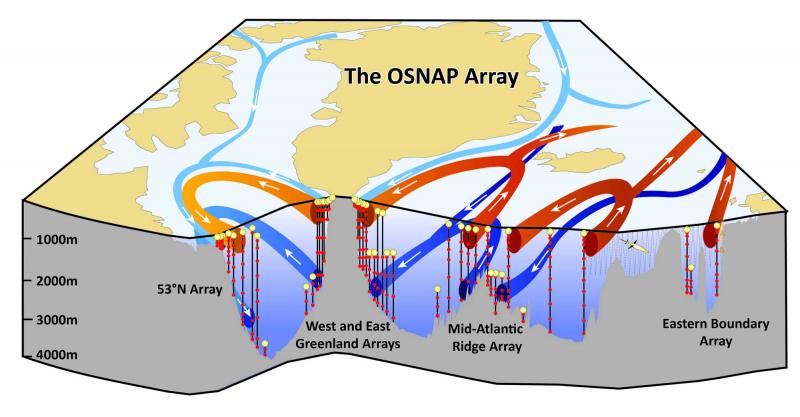
We make six-monthly progress reports to our funding agency, NERC, and you can read those here:
- Progress Report May 2021
- Progress Report October 2020
- Progress report May 2020
- Progress report November 2019
- Progress report May 2019
- Progress report October 2018
- Progress report May 2018
- Progress report September 2017
- Progress report February 2017
- Progress report July 2016
- Progress report January 2016
- Progress report July 2015
- Progress report January 2015
- Progress report July 2014
- Progress report January 2014
Other reports:
UK-OSNAP will showcase physical science and technology through the use of social media, blogs and press releases.
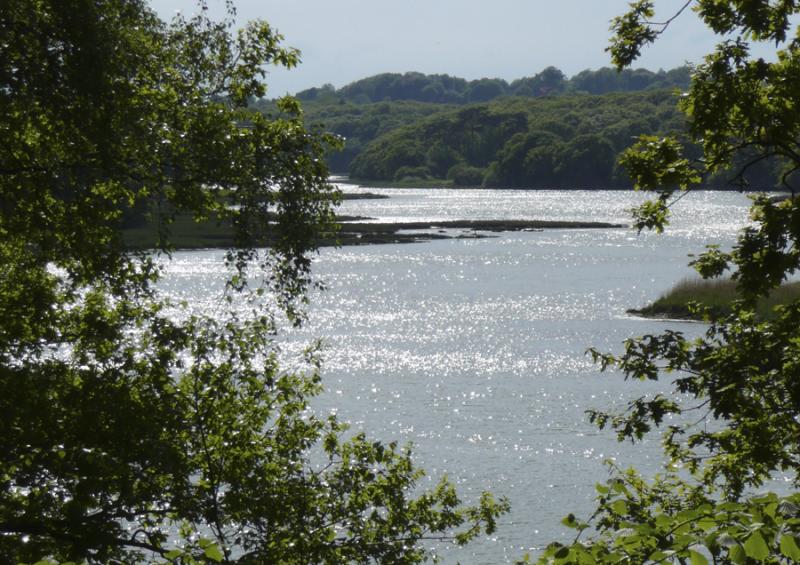
You can watch a range of short films made for the North Atlantic Story Project and featuring UK OSNAP researchers.
We’ve posted some videos from our cruises on the UK OSNAP youtube channel.
UK OSNAP has a blog about our adventures at sea.
Watch this really great film about making OSNAP observations at sea – made by our partners at NIOZ, and featuring UK OSNAP scientists https://www.youtube.com/watch?v=a-lhCIQjE4c&feature=youtu.be
There are loads of interesting animations and videos of ocean data at the University of Liverpool’s Ocean Climate YouTube Channel.
In particular we like the videos that consider different perspectives of sea level change, drawing upon the history of sea-level measurements at Liverpool and our ongoing work on understanding past and present sea-level variability and projections for the future.
Part 1: Personal Perspective www.youtube.com/watch?v=je_wqNSc3Hs
Part 2: Historical Perspective www.youtube.com/watch?v=mbzf4SgbZao
Part 3: Future Perspective? www.youtube.com/watch?v=-8ZpARgVlFI
Listen to a NERC Planet Earth Online podcast about OSNAP.
UK-OSNAP is a partner in NAVIS, the North Atlantic Virtual Institute that seeks to advance scientific understanding of this key component of our climate system by fostering interaction, exchange, collaboration and education.
Who benefits from UK-OSNAP?
The UK-OSNAP programme will generate a large amount of data and information that will have many uses. Some specific groups that will directly benefit are:
Decadal and seasonal forecasters
Knowledge of the sub-polar North Atlantic Ocean is crucial to the skill of emerging seasonal and decadal forecasting systems. OSNAP will increase the quantity and quality of in-situ observations needed to initialise such forecasts. This will be of direct benefit to the UK Meteorological Office.
UK, European and international climate modellers
Observations of ocean heat, freshwater and mass transports within the sub-polar North Atlantic will provide further valuable data to enable assessment, and subsequent refinement, of coupled ocean/climate models used for prediction. The ability of models to simulate ocean transports within the complex sub-polar region is a candid measure of their performance, and affects simulation of related climate processes.
International and domestic climate policy and decision makers
The reduction of the uncertainty of seasonal, decadal and longer-term model forecasts will ultimately contribute to increasingly reliable projections of future climate, thereby underpinning mitigation and adaptation strategies. New understanding of environmental variability is highly valuable to organisations that provide advice for maintaining healthy and productive seas. Combination of OSNAP results with data from other locations will aid detection of any large-scale change in the system that may be underway, or evolve, in the coming years, likely to influence regional climate and require modified adaptation and mitigation policies to those currently in place.
Access to UK-OSNAP data and products
Links to OSNAP data can be found at the international OSNAP website
Journal Articles
2023
Jones, S. C., N. J. Fraser, S. A. Cunningham, A. D. Fox, and M. E. Inall (2023), Observation-based estimates of volume, heat, and freshwater exchanges between the subpolar North Atlantic interior, its boundary currents, and the atmosphere, Ocean Sci., 19(1), 169-192, doi:10.5194/os-19-169-2023
Evans, D. G., Holliday, N. P., Bacon, S., and Le Bras, I. (2023) Mixing and air–sea buoyancy fluxes set the time-mean overturning circulation in the subpolar North Atlantic and Nordic Seas, Ocean Sci., 19, 745–768, https://doi.org/10.5194/os-19-745-2023
Oliver John Tooth, Helen Louise Johnson, Chris Wilson, and Dafydd Gwyn Evans, 2023. Seasonal overturning variability in the eastern North Atlantic subpolar gyre: a Lagrangian perspective. Ocean Science, 19, 769–791. https://os.copernicus.org/articles/19/769/2023/
Yao Fu, M. Susan Lozier, Tiago Carrilho Biló, Amy S. Bower, Stuart A. Cunningham, Frédéric Cyr, M. Femke de Jong, Brad deYoung, Lewis Drysdale, Neil Fraser, Nora Fried, Heather H. Furey Guoqi Han, Patricia Handmann, N. Penny Holliday, James Holte, Mark E. Inall, William E. Johns, Sam Jones, Johannes Karstensen, Feili Li, Astrid Pacini, Robert S. Pickart, Darren Rayner, Fiammetta Straneo, Igor Yashayaev. Seasonality of the Meridional Overturning Circulation in the Subpolar North Atlantic. (2023) Commun Earth Environ 4, 181. https://doi.org/10.1038/s43247-023-00848-9
2022
Berx, Barbara; Volkov, Denis; Baehr, Johanna; Baringer, Molly; Brandt, Peter; Burmeister, Kristin; Cunningham, Stuart; de Jong, Marieke; de Steur, Laura; Dong, Shenfu; Frajka-Williams, Eleanor ; Goni, Gustavo; Holliday, Penny ; Hummels, Rebecca; Ingvaldsen, Randi; Jochumsen, Kerstin; Johns, William; Jónsson, Steingrimur; Karstensen, Johannes; Kieke, Dagmar; Krishfield, Richard; Lankhorst, Matthias; Larsen, Karin; Le Bras, Isabela; Lee, Craig; Li, Feili; Lozier, Susan; Macrander, Andreas; McCarthy, Gerard; Mertens, Christian; Moat, Ben ; Moritz, Martin; Perez, Renellys; Polyakov, Igor; Proshutinsky, Andrey; Rabe, Berit; Rhein, Monika; Schmid, Claudia; Skagseth, Øystein; Smeed, David ; Timmermans, Mary-Louise; von Appen, Wilken-Jon; Williams, Bill; Woodgate, Rebecca; Yashayaev, Igor. 2022 Climate-relevant ocean transport measurements in the Atlantic and arctic oceans. Oceanography. 10-11. https://doi.org/10.5670/oceanog.2021.supplement.02-04
Fraser, Neil J.; Cunningham, Stuart A.; Drysdale, Lewis A.; Inall, Mark E.; Johnson, Clare; Jones, Sam C.; Burmeister, Kristin; Fox, Alan D.; Dumont, Estelle; Porter, Marie; Holliday, N. Penny . 2022 North Atlantic current and European slope current circulation in the Rockall Trough observed using moorings and gliders. Journal of Geophysical Research: Oceans, 127 (12). https://doi.org/10.1029/2022JC019291
Chafik, L., & Holliday, N. P., 2022. Rapid communication of upper-ocean salinity anomaly to deep waters of the Iceland Basin indicates an AMOC short-cut (Commentary). Geophysical Research Letters, 49, e2021GL097570. https://doi.org/10.1029/2021GL097570
Chafik, L., Holliday, N. P., Bacon, S., & Rossby, T. (2022). Irminger Sea is the center of action for subpolar AMOC variability. Geophysical Research Letters, 49, e2022GL099133. https://doi.org/10.1029/2022GL099133
Fox, A. D., Biastoch, A., Cunningham, S. A., Fraser, N., Handmann, P., Holliday, N. P., Johnson, C., Martin, T., Oltmanns, M., Rath, W., Rühs, S., Sanchez-Franks, A., and Schmidt, C., Yashayaev, I.: (2022) Exceptional freshening and cooling in the eastern subpolar North Atlantic caused by reduced Labrador Sea surface heat loss, Ocean Sci. https://doi.org/10.5194/os-2022-18
Koman, G, Johns, WE, Houk, A , Houpert, L, Li, F, (2022) Circulation and overturning in the eastern North Atlantic subpolar gyre, Progress in Oceanography, 208, 102884, https://doi.org/10.1016/j.pocean.2022.102884
Kostov, Y., M.-J. Messias, H. Mercier, H. L. Johnson and D. P. Marshall (2022) Fast mechanisms linking the Labrador Sea with subtropical Atlantic overturning. Climate Dynamics, https://doi.org/10.1007/s00382-022-06459-y
Roussenov, V. M., Williams, R. G., Lozier, M. S., Holliday, N. P., & Smith, D. M. (2022). Historical reconstruction of subpolar North Atlantic overturning and its relationship to density. Journal of Geophysical Research: Oceans, 127, e2021JC017732. https://doi.org/10.1029/2021JC017732
West, G., K. Burmeister and S. A. Cunningham (2022). Reinventing Observations of the Atlantic Meridional Overturning Circulation with Fetch AZA. Journal of Ocean Technology 17: 1-9. https://www.thejot.net/archive-issues/?id=78 (Subscription required for access)
2021
Fraser, N. J., & Cunningham, S. A. (2021). 120 years of AMOC variability reconstructed from observations using the Bernoulli inverse. Geophysical Research Letters, 48, e2021GL093893. https://doi.org/10.1029/2021GL093893
Desbruyères Damien, Chafik Léon, Maze Guillaume (2021). A shift in the ocean circulation has warmed the subpolar North Atlantic Ocean since 2016 . Nature Communications Earth & Environment , 2(1), 48 (9p.) https://doi.org/10.1038/s43247-021-00120-y
Petit T., M.S. Lozier, S.A. Josey, S.A. Cunningham. (2021) Role of Air–sea Fluxes and Ocean Surface Density in the Production of Deep Waters in the Eastern Subpolar Gyre of the North Atlantic. Ocean Science, 17(5), pp. 1353–1365. doi: 10.5194/os-17-1353-2021. https://doi.org/10.5194/os-17-1353-2021
Zou, S., Bower, A.S, Furey, H., Pickart, R.S., Houpert, L., Holliday, N.P. 2021 Observed Deep Overflow Cyclones around Greenland. Journal of Physical Oceanography, https://doi.org/10.1175/JPO-D-20-0288.1
F. Li, M. S. Lozier, N. P. Holliday, W. E. Johns, I. A. Le Bras, B. Moat, S. A. Cunningham, M. F. de Jong. 2021. Observation-based estimates of heat and freshwater exchanges from the subtropical North Atlantic to the Arctic. Progress in Oceanography, 197, https://doi.org/10.1016/j.pocean.2021.102640
F. Li, M.S. Lozier, S. Bacon, A. Bower, S.A. Cunningham, M.F. de Jong, B. DeYoung, N. Fraser, N. Fried, G. Han, N.P. Holliday, J. Holte, L. Houpert, M.E. Inall, W.E. Johns, S. Jones, C. Johnson, J. Karstensen, I.A. LeBras, P. Lherminier, X. Lin, H. Mercier, M. Oltmanns, A. Pacini, T. Petit, R.S. Pickart, D. Rayner, F. Straneo, V. Thierry, M. Visbeck, I. Yashayaev, C. Zhou. 2021. Subpolar North Atlantic western boundary density anomalies and the Meridional Overturning Circulation. Nat Commun 12, 3002 (2021). https://doi.org/10.1038/s41467-021-23350-2
Kostov, Y., Johnson, H.L., Marshall, D.P., Heimbach, P., Forget, G, Holliday, N.P., Lozier, M.S., Li, F., Pillar, H.R., Smith, T. 2021, Contrasting sources of variability in subtropical and subpolar Atlantic overturning. Nature Geosciences 10.1038/s41561-021-00759-4
Gould, J. W., and S. A. Cunningham (2021), Global-scale patterns of observed sea surface salinity intensified since the 1870s, Nature Communications Earth & Environment, doi.org/10.1038/s43247-021-00161-3.
Pacini, A., Pickart, R., Le Bras, I., Straneo, F. Holliday, N.P. 2021, Cyclonic eddies in the West Greenland Boundary Current System. JPO, https://doi.org/10.1175/JPO-D-20-0255.1
Le Bras, I., Straneo, F., Muilwijk, M., Smedsrud, L.H., Li, Feili, Lozier, M.S., Holliday, N.P.. 2021, How much Arctic fresh water participates in the subpolar overturning circulation? JPO, 51(3), 955-973. https://doi.org/10.1175/JPO-D-20-0240.1
MacGilchrist, Johnson, Lique and Marshall (2021) Demons in the North Atlantic: Variability of Deep Ocean Ventilation, GRL, https://doi.org/10.1029/2020GL092340
Tsubouchi, T., K. Våge, B. Hansen, K. M. H. Larsen, S. Østerhus, C. Johnson, S. Jónsson and H. Valdimarsson (2021). Increased ocean heat transport into the Nordic Seas and Arctic Ocean over the period 1993–2016. Nature Climate Change 11(1): 21-26. https://www.nature.com/articles/s41558-020-00941-3
2020
Petit, T., Lozier, M. S., Josey, S. A., & Cunningham, S. A. 2020. Atlantic deep water formation occurs primarily in the Iceland Basin and Irminger Sea by local buoyancy forcing. Geophysical Research Letters, 47, e2020GL091028. https://doi.org/10.1029/2020GL091028
Desbruyères, D. G.; Sinha, B.; McDonagh, E. L.; Josey, S. A.; Holliday, N. P.; Smeed, D. A. ; New, A. L.; Megann, A.; Moat, B. I. . 2020 Importance of boundary processes for heat uptake in the Subpolar North Atlantic. Journal of Geophysical Research: Oceans, 125 (9), e2020JC016366. https://doi.org/10.1029/2020JC016366
Houpert, L. Cunningham, S.; Fraser, N.; Johnson, C.; Holliday, N. P., Jones, S.; Moat, B.; Rayner, D., 2020 Observed variability of the North Atlantic current in the Rockall Trough from four years of mooring measurements. Journal of Geophysical Research: Oceans, 125 (10), e2020JC016403. https://doi.org/10.1029/2020JC016403
Rossby, T., Chafik, L., & Houpert, L, 2020. What can hydrography tell us about the strength of the Nordic Seas MOC over the last 70 to 100 years?.Geophysical Research Letters, 47,e2020GL087456. https://doi.org/10.1029/2020GL087456
Mackay, N., Wilson, C., Holliday, N.P., Zika, J.D., 2020. The observation-based application of a Regional Thermohaline Inverse Method to diagnose the formation and transformation of water masses north of the OSNAP array from 2013-2015. JPO, 50, 1533-1555. https://doi.org/10.1175/JPO-D-19-0188.1
Huthnance, J.M., Inall, M.E., Fraser, N.J., 2020, Oceanic density/pressure gradients and slope currents. Journal of Physical Oceanography, DOI: 10.1175/JPO-D-19-0134.1
Johnson, C., M. Inall, S. Gary and S. Cunningham, 2020, Significance of climate indices to benthic conditions across the northern North Atlantic and adjacent shelf seas, Frontiers in Marine Science, 7, doi: 10.3389/fmars.2020.00002.
Holliday, N. Penny; Bersch, Manfred; Berx, Barbara; Chafik, Léon; Cunningham, Stuart; Florindo-López, Cristian; Hátún, Hjálmar; Johns, William; Josey, Simon A.; Larsen, Karin Margretha H.; Mulet, Sandrine; Oltmanns, Marilena; Reverdin, Gilles; Rossby, Tom; Thierry, Virginie; Valdimarsson, Hedinn; Yashayaev, Igor. 2020 Ocean circulation causes the largest freshening event for 120 years in eastern subpolar North Atlantic. Nature Communications, 11 (1), 585. https://doi.org/10.1038/s41467-020-14474-y
Le Bras, I. A.‐A.; Straneo, F.; Holte, J.; Jong, M. F.; Holliday, N. P.. 2020 Rapid export of waters formed by convection near the Irminger Sea's western boundary. Geophysical Research Letters, 47 (3), e2019GL085989. https://doi.org/10.1029/2019GL085989
2019
Benetti, M.; Reverdin, G.; Clarke, J.S.; Tynan, E.; Holliday, N.P.; Torres‐Valdes, S.; Lherminier, P.; Yashayaev, I.. 2019 Sources and distribution of fresh water around Cape Farewell in 2014. Journal of Geophysical Research: Oceans. Journal of Geophysical Research Oceans, 124, 9404–9416.https://doi.org/10.1029/2019JC015080
González-Pola, César; Fratantoni, Paula; Larsen, Karin M. H.; Holliday, N. Penny; Dye, Stephen; Mork, Kjell Arne; Beszczynska-Möller, Agnieszka; Valdimarsson, Hedinn; Trofimov, Alexander; Parner, Hjalte; Klein, Holger; Cisewski, Boris; Fontán, Almudena; Lyons, Kieran; Kolodziejczyk, Nicolas; Graña, Rocío; Linders, Johanna; Wodzinowski, Tycjan; Goszczko, Ilona; Cusack, Caroline. 2019 The ICES Working Group on Oceanic Hydrography: A Bridge From In-situ Sampling to the Remote Autonomous Observation Era. Frontiers in Marine Science, 6. https://doi.org/10.3389/fmars.2019.00103
Kostov, Y., Johnson, H.L., Marshall, D.P. (2019) AMOC sensitivity to surface buoyancy fluxes: the role of air-sea feedback mechanisms. Climate Dynamics. doi: https://doi.org/10.1007/s00382-019-04802-4
Moat; B. Sinha; S. A. Josey; J. Robson; P. Ortega; F. Sévellec; N. P. Holliday; G. D. McCarthy; A. L. New; J. J.-M. Hirschi. 2019. New insights into decadal North Atlantic sea surface temperature and ocean heat content variability from a high-resolution coupled climate model, Journal of Climate. 32 (18). 6137-6161.https://doi.org/10.1175/JCLI-D-18-0709.1
Eleanor Frajka-Williams, Isabelle J Ansorge, Johanna Baehr, Harry L Bryden, Maria Paz Chidichimo, Stuart A Cunningham, Gokhan Danabasoglu, Shenfu Dong, Kathleen A Donohue, Shane Elipot, N. Penny Holliday, Rebecca Hummels, Laura C Jackson, Johannes Karstensen, Matthias Lankhorst, Isabela Le Bras, M. Susan Lozier, Elaine L McDonagh, Christopher S Meinen, Herle Mercier, Bengamin I Moat, Renellys C Perez, Christopher G Piecuch, Monika Rhein, Meric Srokosz, Kevin Edward Trenberth, Sheldon Bacon, Gael Forget, Gustavo Jorge Goni, Patrick Heimbach, Dagmar Kieke, Jannes Koelling, Tarron Lamont, Gerard McCarthy, Christian Mertens, Uwe Send, David A Smeed, Marcel van den Berg, Denis Volkov, Chris Wilson, 2019, Atlantic Meridional Overturning Circulation: observed transport and variability. Frontiers in Marine Science, Ocean Observations, 6:260, https://doi.org/10.3389/fmars.2019.00260
Hopkins, J. E. , N. P. Holliday, S. Bacon, D. Rayner, L. Houpert, I. Le Bras, F. Straneo, C. Wilson, Transport variability of the Irminger Sea Deep Western Boundary Current from a mooring array. 2019. Journal of Geophysical Research: Oceans, 124, 3246–3278. https://doi.org/10.1029/2018JC014730
Li, F., Lozier, M.S., Danabasoglu, G., Holliday, N.P., Kwon, Y.-O., Romanou, A., Yeager, S. G., Zhang, R., 2019. Local and downstream relationship between Labrador Sea Water volume and North Atlantic meridional overturning circulation variability. J. Climate, 32, 3883-3898. https://doi.org/10.1175/JCLI-D-18-0735.1
González-Pola C, Fratantoni P, Larsen KMH, Holliday NP, Dye S, Mork KA, Beszczynska-Möller A, Valdimarsson H, Trofimov A, Parner H, Klein H, Cisewski B, Fontán A, Lyons K, Kolodziejczyk N, Graña R, Linders J, Wodzinowski T, Goszczko I and Cusack C (2019) The ICES Working Group on Oceanic Hydrography: A Bridge From In-situ Sampling to the Remote Autonomous Observation Era. Front. Mar. Sci. 6:103. doi: 10.3389/fmars.2019.00103
Lozier, M.S., F. Li, S. Bacon, F. Bahr, A. Bower, S. Cunningham, F. de Jong, L. de Steur, Brad de Young, J. Fischer, S. Gary, B. Greenan, N.P. Holliday, A. Houk, L. Houpert, M. Inall, B. Johns, H. Johnson, C. Johnson, J. Karstensen, G. Koman, I. LeBras, X. Lin, N. Mackay, D. Marshall, H. Mercier, M. Oltmanns, R. Pickart, A. Ramsay, D. Rayner, F. Straneo, V. Thierry, D. Torres, R. Williams, C. Wilson, J. Yang, I. Yashayaev, J. Zhao. 2019. A sea change in our view of overturning in the Subpolar North Atlantic Program. Science 01 Feb 2019:Vol. 363, Issue 6426, pp. 516-521 DOI: 10.1126/science.aau6592
2018
Le Bras, I. A.-A., Straneo, F., Holte, J., & Holliday, N. P. (2018). Seasonality of freshwater in the East Greenland Current system from 2014 to 2016. Journal of Geophysical Research: Oceans, 123, 8828–8848. https://doi.org/10.1029/2018JC014511
Pillar, H. R., H. L. Johnson, D. P. Marshall, P. Heimbach, and S. Takao, 2018: Impacts of Atmospheric Reanalysis Uncertainty on AMOC Estimates at 25N. J. Climate, 31, 8719-8744.
Houpert L., M. Inall E. Dumont S. Gary C. Johnson M. Porter W. E. Johns S. A. Cunningham, 2018, Structure and Transport of the North Atlantic Current in the Eastern Subpolar Gyre from Sustained Glider Observations, Journal of Geophysical Research-Oceans, https://doi.org/10.1029/2018JC014162
Zhao, J., Bower, A., Yang, J., Lin, X., Holliday, N.P., 2018, Meridional heat transport variability induced by mesoscale processes in the subpolar North Atlantic, Nature Communications, 9:1124, doi:10.1038/s41467-018-03134-x
Holliday, N.P., Bacon, S., Cunningham, S., Gary, S.F., Karstensen, J., King, B.A., Li, F., McDonagh, E.L. 2018, Subpolar North Atlantic overturning and gyre-scale circulation in the summers of 2014 and 2016. JGR-Oceans, 123(7), 4538-4559, 10.1029/2018JC013841
Mackay, N, Wilson, C., Zika, J., Holliday, N.P., 2018, A regional thermohaline inverse method for estimating circulation and mixing in the Arctic, Journal of Ocean and Atmosphere Technology, DOI: 10.1175/JTECH-D-17-0198.1
Gary, S. F., Cunningham, S. A., Johnson, C., Houpert, L., Holliday, N.P., Behrens, E., Biastoch, A., Boning, C. 2018. Seasonal cycles of oceanic transport in the eastern subpolar North Atlantic. JGR-Oceans, 123 (2), 1471-1484, doi 10.1002/2017JC013350
2017
Ferrari, R., L.-P. Nadeau, D. P. Marshall, L .C. Allison, and H. L. Johnson, 2017: A model of the ocean overturning circulation with two closed basins and a re-entrant channel. J. Phys. Oceanogr., 47, 2887-2906.
Marshall, D. P., and H. L. Johnson, 2017: Relative strength of the Antarctic Circumpolar Current and Atlantic Meridional Overturning Circulation. Tellus A, 69, 1338884.
Johnson, C., Cunningham, S., Sherwin, T., Dumont, E., Houpert, L., Holliday, N.P., Gary, S., (2017). Pathways and transports of overflow water in the Rockall Trough. doi: 10.1016/j.dsr.2017.02.004,
Benetti, M., Reverdin, G., Yashayaev, I., Holliday, N.P., Tynan, E., Torres-Valdes, S., Lherminier, P., Treguer, P., Sarthou, G., Lique, C., (2017), Composition of freshwater in the spring 2014 on the southern Labrador shelf and slope. JGR, doi: 10.1002/2016JC012244
2016
Lozier, M. S. Bacon, S., Bower, A. S., Cunningham, S. A. de Jong, M. F., de Steur, L., deYoung, B., Fischer, J., Gary, S. F., Greenan, B. J.W., Heimbach, P., Holliday, N. P., Houpert, L., Inall, M.E., Johns, W. E., Johnson, H. L., Karstensen, J.,Li, Feili; Lin, X., Mackay, N., Marshall, D. P., Mercier, H., Myers, P. G., Pickart, R. S., Pillar, H. R. Straneo, F., Thierry, V., Weller, R A., Williams, R. G., Wilson, C., Yang, J., Zhao, J., Zika, J. D., 2016 Overturning in the Subpolar North Atlantic Program: a new international ocean observing system. Bulletin of the American Meteorological Society, 10.1175/BAMS-D-16-0057.1
Doddridge, E. W., D. P. Marshall, and A. McC. Hogg, 2016: Eddy cancellation of the Ekman cell in subtropical gyres. J. Phys. Oceanogr., 46, 2995-3010.
Pillar, H., Heimbach, P., Johnson, H. and Marshall, D. (2016), Dynamical attribution of recent variability in Atlantic overturning, Journal of Climate, 29, 3339-3352, 10.1175/JCLI-D-15-0727.1
2015
Munday, D. R., H. L. Johnson, and D. P. Marshall, 2015: The role of ocean gateways in the dynamics and sensitivity to wind stress of the early Antarctic Circumpolar Current. Paleoceanography, 30, 284–302.
Williams, R.G., V. Roussenov, M.S. Lozier, D. Smith (2015). Mechanisms of heat content and thermocline change in the subtropical and subpolar North Atlantic. J. Climate, 10.1175/JCLI-D-15-0097.1
Holliday, N. P., S. A. Cunningham, C. Johnson, S. Gary, C. Griffiths, J. F. Read, and T. Sherwin (2015), Multi-decadal variability of potential temperature, salinity and transport in the eastern subpolar North Atlantic, J. Geophys. Res. - Oceans, 10.1002/2015JC010762.
Sherwin, T. J., Aleynik, D. L., Inall, M. E. & Dumont, E. (2015) Deep drivers of mesoscale circulation in the central Rockall Trough. Ocean Science, doi:10.5194/os-11-343-2015
Marzocchi, A., J. Hirschi, J.-M, N. P. Holliday, S. A. Cunningham, A. T. Blaker, and A. C. Coward (2015), The North Atlantic subpolar circulation in an eddy-resolving global ocean model, Journal of Marine Systems, 142, 126-143, doi:10.1016/j.jmarsys.2014.10.007.
2014
Williams et al, 2014. Decadal evolution of ocean thermal anomalies in the North Atlantic: the effects of Ekman, overturning, and horizontal transport. Journal of Climate, 27, 2, 698-719.
2013
Cunningham, S. A., C. D. Roberts, E. Frajka-Williams, W. E. Johns, W. Hobbs, M. Palmer, D. Rayner, D. A. Smeed, and G. McCarthey (2013), Atlantic Meridional Overturning Circulation slowdown causes widespread cooling in the Atlantic, Geophys. Res. Letters, 40, 6202-6207, doi:6210.1002/2013GL058464.
Johnson, C., M. Inall, and S. Häkkinen (2013), Declining nutrient concentrations in the northeast Atlantic as a result of a weakening Subpolar Gyre, Deep Sea Research I, 82, 95-107.
Reports
Holliday et al, 2017, RRS Discovery Cruise DY078 06 - 28 May 2017, Southampton to Reykjavik. Extended Ellett Line 2017 occupation and OSNAP Rockall Trough mooring refurbishment cruise. Southampton, National Oceanography Centre, 118pp. (National Oceanography Centre Cruise Report 48)
Cunningham, S., Houpert, L., et al, (2016), RRS Discovery Cruise DY053, 26 Jun - 23 Jul 2016, Glasgow to Reykjavik. OSNAP 2016 mooring refurbishment cruise, Leg 1. SAMS Report, 121pp.
Holliday, N.P.; et al, (2016), RRS Discovery Cruise DY054, 27 Jul - 17 Aug 2016, Reykjavik to Southampton. OSNAP 2016 mooring refurbishment cruise, Leg 2. Southampton, National Oceanography Centre, 77pp. (National Oceanography Centre Cruise Report 40)
Johnson, C., S. Cunningham, J. Fischer, S. Gary, J. Karstensen, T. Liblik, and L. de Steur (2016a), Report on the upper and lower transport variability at NACLIM key section in the Subpolar gyre of the North Atlantic, NACLIM Deliverable D22.31 Rep., http://naclim.zmaw.de/index.php?id=2247.
Cunningham, S. A. (2015), R/V Knorr Cruise KN221-02,Rep 288., 1-50pp, SAMS.
King, B.A.; Holliday, N.P.; et al, .. 2015 RRS James Clark Ross Cruise 302, 06 Jun - 21 Jul 2014, The 2015 RAGNARRoC, OSNAP AND Extended Ellett Line cruise report. Southampton, National Oceanography Centre, 76pp. (National Oceanography Centre Cruise Report 35)
Cunningham, S. A. (2014), The Oceans, in The Times Comprehensive Atlas of the World 14th edition, edited, pp. 32-33, HarperCollins, Glasgow.
Pickart, R. (2014), R/V Knorr Cruise KN221-03, 1-64pp, WHOI
Karstensen, J., and C. Johnson (2014), Report on the technical characteristic of the observing system operated in NACLIM south of the sills, Work package 2.2, Deliverable 22.8Rep., 33pp pp, University of Hamburg, Hamburg.
